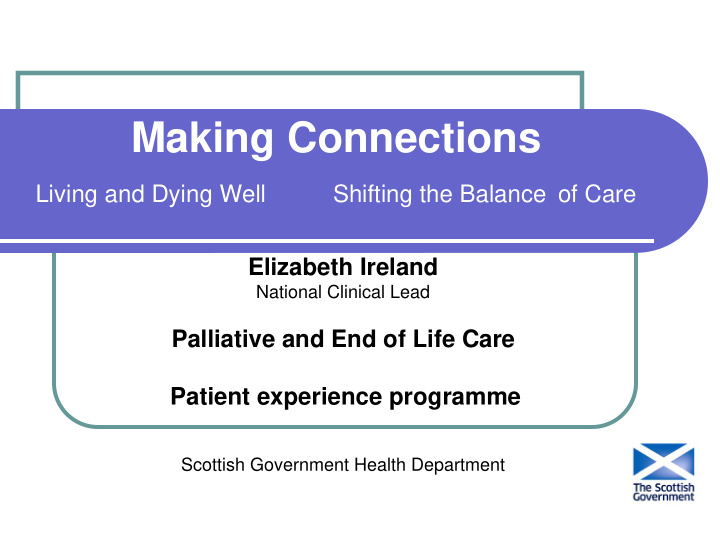



Making Connections Living and Dying Well Shifting the Balance of Care Elizabeth Ireland National Clinical Lead Palliative and End of Life Care Patient experience programme Scottish Government Health Department
Improving Experience • SHIFTING FOCUS EXPERI ENCE • SHIFTING WHO DELIVERS CARE • SHIFTING LOCATION of CARE EVI DENCE BASED PRACTI CE MODELS of CARE Working in Partnership I mproving Outcomes
hifting the Balance of Care links to Health & Wellbeing Outcomes mprovement areas shifts/impact Maximise flexible and responsive care at home, with Improved individual National support for carers experience Performance Integrate health and social care Framework Increased independence and support for people in need and personal choice and at risk Reduce avoidable unscheduled Prevent adverse events Single attendances and admissions by earlier interventions outcome to acute hospitals agreements Decreased institutional Improve capacity & flow for beddays scheduled care Extend scope of services Better use of medical and non medical professionals provided by non-medical practitioners outside acute HEAT hospital Use existing technology targets as fully as possible Improve access to care for remote and rural populations Reduced inequalities in time and geography Improve palliative and end of life care (EOL) Reduced overall Improve joint use of resources infrastructure costs and (capital and revenue) minimise carbon footprints
Policy and Strategies etc- Palliative Care in Scotland
Public Audit Committee � National consistent and accurate data collection � Robust commissioning arrangements � Single National DNAR policy across Scotland
LIVING and DYING WELL
Palliative Care for whom? diagnosis of a progressive or � life-limiting illness critical events or significant � deterioration during the disease trajectory indicating the need for a change in care and management significant changes in patient or � carer ability to ‘cope ’ indicating the need for additional support the ‘ surprise question ’ � (clinicians would not be surprised if the patient were to die within the next 12 months) onset of the end of life phase – � ‘ diagnosing dying’
Number of comorbidities by age 12.8 24.3 12.5 38.6 16.4 18.4 Percentage 16.1 20.1 22.5 16.9 19.2 21.1 15 13.6 8.8 12.7 6.4 4.6 55-64 65-74 75+ Age 0 1 2 3 4 5
From ISD Place of death. Scotland 1981 to 2006 Source GRO Scotland 100% 90% 80% 70% 60% Home 50% Nursing Homes etc. 40% Hospital 30% 20% 10% 0% 1 2 3 4 5 6 7 8 9 0 1 2 3 4 5 6 7 8 9 0 1 2 3 4 5 6 8 8 8 8 8 8 8 8 8 9 9 9 9 9 9 9 9 9 9 0 0 0 0 0 0 0 9 9 9 9 9 9 9 9 9 9 9 9 9 9 9 9 9 9 9 0 0 0 0 0 0 0 1 1 1 1 1 1 1 1 1 1 1 1 1 1 1 1 1 1 1 2 2 2 2 2 2 2
Actual and Projected deaths 1974-2030 Gomes and Higginson. Palliative Medicine 2008
So by 2030… if current trends continue � home deaths will reduce by 42.3% � Less than one in 10 (9.6%) will die at home � increase in institutional deaths of 20.3%.
Patient Journey Emergency admissions Mean number of emergency admissions per year (denominator = number of deaths 2006) 2.5 Mean number of emergency admissions per year 2.0 1.5 1.0 0.5 0.0 0-1 1-2 2-3 3-4 4-5 Years of life left Cancer Heart disease Other disorders of the circulatory system Other diseases of the respiratory system COPD
Patient Journey Length of Stay Bed days in the last 5 years of life For persons who died in 2006 1,600,000 1,400,000 1,200,000 Emergencies 1,000,000 Transfers B ed d ays Electives 800,000 600,000 400,000 200,000 0 1 2 3 4 5 Years of life left
and the costs…
Living and Dying Well
LIVING and DYING WELL •Assessment and Review of palliative and end of life care needs •Planning and delivery of care for patients with palliative and end of life care needs •Communication and Coordination •Education, training and workforce development •Implementation and future developments
Activities from Living and Dying Well � Board Delivery Plans � Identification and Assessment tools � Palliative Care Registers � Anticipatory Prescribing � Service Information Directories � DNAR � Community Nursing � Equipment � Education champions
Activities from Living and Dying Well � Education � eHealth � ePCS
Palliative Care Dataset � Captured within GP system – some already pre-populated: � Palliative care register flag (Read code) consent � Carer details and key professionals � Diagnosis and current treatment � Preferred place of care � Current care arrangements � Patients and Carers Awareness of Conditions � Advice for OOH care � Including DNAR
Activities from Living and Dying Well � Education � eHealth � ePCS � Voluntary sector � SCI � Care Commission � Care standards � Education � Palliative Care Standards
Living and Dying Well Implementation of
For Discussion Composite measures? � Preferred place of care? � Palliative Care Register? � LCP? � DNAR?
Recommend
More recommend